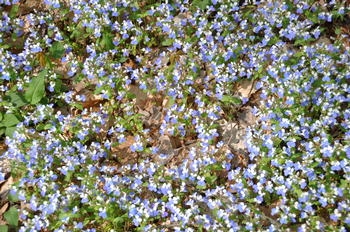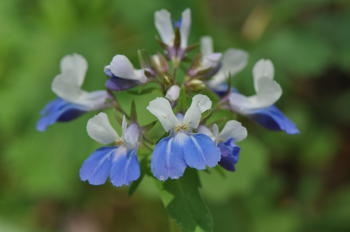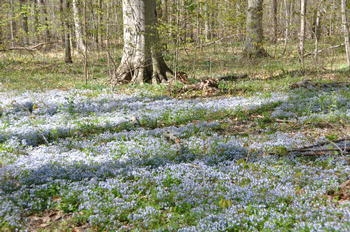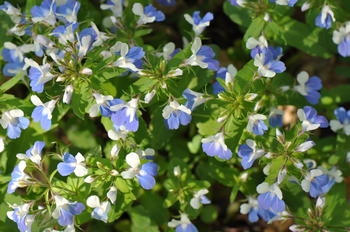Plants and Animals
Collinsia verna Blue-eyed Mary
Key Characteristics
Short winter annual herb of rich forests in southern Michigan; 20 to 40 cm tall, unbranched stem with opposite leaves; contains 1 to 3 whorls of 4 to 6 flowers and a bicolored corolla with an upper white lip and a lower blue lip.
Status and Rank
US Status: No Status/Not Listed
State Status: T - Threatened (legally protected)
Global Rank: G5 - Secure
State Rank: SNR - Not ranked
Occurrences
| County | Number of Occurrences | Year Last Observed |
|---|---|---|
| Allegan | 1 | 1940 |
| Berrien | 6 | 2018 |
| Cass | 6 | 2020 |
| Clinton | 1 | 1886 |
| Eaton | 3 | 2012 |
| Gratiot | 1 | 1886 |
| Hillsdale | 2 | 1957 |
| Ingham | 3 | 1995 |
| Ionia | 1 | 1886 |
| Kalamazoo | 3 | 2017 |
| Kent | 2 | 1897 |
| Lenawee | 3 | 1983 |
| Montcalm | 1 | 1886 |
| Ottawa | 1 | 1966 |
| Washtenaw | 1 | 1894 |
Information is summarized from MNFI's database of rare species and community occurrences. Data may not reflect true distribution since much of the state has not been thoroughly surveyed.
Habitat
Found in moist soil rich beech-maple forests with a rich humus layer, and on levees and terraces within floodplain forests.
Natural Community Types
For each species, lists of natural communities were derived from review of the nearly 6,500 element occurrences in the MNFI database, in addition to herbarium label data for some taxa. In most cases, at least one specimen record exists for each listed natural community. For certain taxa, especially poorly collected or extirpated species of prairie and savanna habitats, natural community lists were derived from inferences from collection sites and habitat preferences in immediately adjacent states (particularly Indiana and Illinois). Natural communities are not listed for those species documented only from altered or ruderal habitats in Michigan, especially for taxa that occur in a variety of habitats outside of the state.
Natural communities are not listed in order of frequency of occurrence, but are rather derived from the full set of natural communities, organized by Ecological Group. In many cases, the general habitat descriptions should provide greater clarity and direction to the surveyor. In future versions of the Rare Species Explorer, we hope to incorporate natural community fidelity ranks for each taxon.
Associated Plants
Sugar maple (Acer saccharum), cut-leaved toothwort (Cardamine concatenata), false rue anemone (Enemion biternatum), yellow trout lily (Erythronium americanum), running strawberry-bush (Euonymus obovatus), American beech (Fagus grandifolia), false mermaid weed (Floerkea proserpinacoides), sticky willy (Galium aparine), Canada waterleaf (Hydrophyllum canadense), false Solomon’s seal (Maianthemum racemosum),Virginia bluebells (Mertensia virginica), ironwood (Ostrya virginiana), Virginia creeper (Parthenocissus quinquefolia), May-apple (Podophyllum peltatum), wild black cherry (Prunus serotina), gooseberries (Ribes spp.), red elderberry (Sambucus racemosa), sassafrass (Sassafras albidum), American elm (Ulmus americana), and violets (Viola spp.).
Management Recommendations
Protection of existing habitat is essential. This species was once widespread in southern Michigan but has declined precipitously in recent decades due to habitat loss. Conserve hydrology of river system and corresponding cyclical floodplain regime. Maintain healthy intact, mature floodplain and mesic southern forests and minimize forest fragmentation. When possible, leave large tracts of unharvested forests and allow natural processes such as windthrow to operate unhindered.
Survey Methods
Random meander search covers areas that appear likely to have rare taxa, based on habitat and the judgment of the investigator.
-
Meander search
-
Survey Period: From fourth week of April to first week of June
-
References
Survey References
- Elzinga, C.L., D.W. Salzer, and J.W. Willoughby. 1998. Measuring and Monitoring Plant Populations. The Nature Conservancy and Bureau of Land Management, Denver. BLM Technical Reference 1730-1. 477pp.
- Goff, G.F., G.A. Dawson, and J.J. Rochow. 1982. Site examination for Threatened and Endangered plant species. Environmental Management 6(4): 307-316
- Nelson, J.R. 1984. Rare Plant Field Survey Guidelines. In: J.P. Smith and R. York. Inventory of rare and endangered vascular plants of California. 3rd Ed. California Native Plant Society, Berkeley. 174pp.
- Nelson, J.R. 1986. Rare Plant Surveys: Techniques For Impact Assessment. Natural Areas Journal 5(3):18-30.
- Nelson, J.R. 1987. Rare Plant Surveys: Techniques for Impact Assessment. In: Conservation and management of rare and endangered plants. Ed. T.S. Elias. California Native Plant Society, Sacramento. 8pp.
Technical References
- Baskin, J.M., and C.C. Baskin. 1983. Germination ecology of Collinsia verna, a winter annual of rich deciduous woodlands. Bulletin of the Torrey Botanical Club 110(3): 311–315.
- Gleason, H. A., and A. Cronquist. 1991. Manual of Vascular Plants of Northeastern United States and Adjacent Canada. Second edition. The New York Botanical Garden, Bronx. 910pp.
- Gray, A. 1950. Gray's Manual of Botany; eighth ed. Van Nostrand Reinghold, New York. 1632pp.
- Holmgren, N.H. 1998. Illustrated Companion to Gleason and Cronquist's Manual. Illustrations of the vascular plants of Northeastern United States and adjacent Canada. New York Botanical Garden, Bronx. 937pp.
- Kalisz, S., and M.A. McPeek. 1992. Demography of an age-structured annual: Resampled projection matrices, elasticity analyses, and seed bank effects. Ecology 73(3): 1082–1093.
- Kalisz, S., D.W. Vogler, and K.M. Hanley. 2004. Context-dependent autonomous self-fertilization yields reproductive assurance and mixed mating. Nature 430: 884–887.
- Park, M.S. 2019. Collinsia. In: Flora of North America Editorial Committee, eds. 1993+. Flora of North America North of Mexico. 19+ vols. New York and Oxford. Vol. 17, pp. 62–74.
- Reznicek, A.A., E.G. Voss, and B.S. Walters. 2011. Collinsia verna Nutt. Michigan Flora. Michigan Flora Online. University of Michigan. Web. Available at: https://www.michiganflora.net/species.aspx?id=1938 [Accessed March 31, 2020].
- Spigler, R.B., and S. Kalisz. 2013. Phenotypic plasticity in mating-system traits in the annual Collinsia verna. Botany 91: 597–604.
- Swink, F. and G. Wilhelm. 1994. Plants of the Chicago Region, 4th ed. Indiana Academy of Science, Indianapolis. 921pp.
- Voss, E.G., and A.A. Reznicek. 2012. Field Manual of Michigan Flora. University of Michigan Press, Ann Arbor, MI. 1008 pp.





